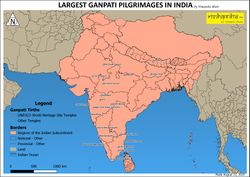Ganapatya is the religious sect that primarily worships Ganapati, the person of the Matang-Guhyak gotra who led the Devas to victory in wars against Asuras. He is shown elephant-headed, as are others of this gotra, and he was the son of Siva and Parvati. While Ganapati worship is done in all the major traditions, the Ganapatya religious sect treats Ganapati as the Supreme Godhead, Akshara Brahman. Besides the Veda and Saiva Puranas, the main scriptures followed by Ganapatya-s are the Ganapatya Agama-s. The religion is most prevalent in Maharasthra.
|
In this book, we analyze the psycho-social consequences faced by Indian American children after exposure to the school textbook discourse on Hinduism and ancient India. We demonstrate that there is an intimate connection—an almost exact correspondence—between James Mill’s colonial-racist discourse (Mill was the head of the British East India Company) and the current school textbook discourse. This racist discourse, camouflaged under the cover of political correctness, produces the same psychological impacts on Indian American children that racism typically causes: shame, inferiority, embarrassment, identity confusion, assimilation, and a phenomenon akin to racelessness, where children dissociate from the traditions and culture of their ancestors.
|


